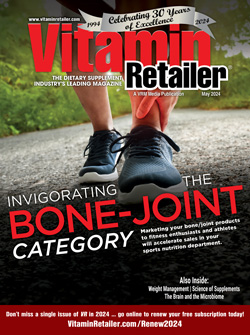Inflammation is a major mechanism involved in many human diseases. Since prolonged inflammation is detrimental to the host, higher organisms have evolved protective mechanisms to ensure resolution of the inflammatory response in a limited and specific time- and space-manner. Once thought as a mere passive process of dilution of inflammation, resolution is today envisioned as a highly orchestrated process coordinated by a complex regulatory network of cells and mediators.1
Nuclear Factor-kappa Beta
One such mediator is nuclear factor-kappa Beta (NF-κB), a protein that acts as a sort of switch to turn inflammation on and off in the body. In response to threats like free radicals and infectious agents, as well as injury, NF-κB “turns on” genes that produce inflammation. As we age, NF-κB expression in the body increases, provoking widespread chronic inflammation and setting the stage for diseases ranging from arthritis and atherosclerosis to diabetes and Alzheimer’s. Evidence from recent research suggests that by inhibiting NF-κB, a wide range of diseases and conditions in which inflammation plays a critical role can be treated.2
Andrographis paniculata: Background and Animal Research
Enter Andrographis paniculata, an herb with a history of use in both ayurvedic and traditional Chinese medicine. Called the “king of bitters” in Asia, andrographis contains a number of bitter constituents, which appear to have both immune-modulating and anti-inflammatory activity.3 Specifically, during the screening of a plant extract library of traditional Chinese herbal medicines, researchers found that NF-κB activity was potently inhibited by andrographolide, an abundant component of the plant andrographis.4 Subsequent research verified this effect, and further demonstrated that andrographolide also reduced the expression of other pro-inflammatory proteins, such as COX-2.5 In fact, a recent article in the scientific journal Biochemical Pharmacology, suggested that “andrographolide and its analogs have great potential to be the next new class of anti-inflammatory agents …”6
The anti-inflammatory effects of andrographis were examined in various types of animal studies. In a study7 with mice, Andrographis extract significantly inhibited myocardial inflammation-related proteins caused by a high fat diet. In another mouse study,8 andrographolide ameliorated drug-induced diabetic retinopathy by reducing inflammation, including NF-κB. In other research9 with mice, andrographolide was found to be an effective anti-inflammatory agent for lung inflammation.
Andrographis paniculata: In-vitro Joint and Cartilage Research
The demonstrated anti-inflammatory effect of andrographis and its andrographolides also have a direct effect on cartilage. This has important ramifications for joint health.
Osteoarthritis is characterized by progressive and permanent cartilage degradation. Cartilage erosion can cause inflammation and pain, decreased mobility and reduced athletic performance. This degradation is caused by Interleukin-1β (IL-1β) cytokines, which trigger the over-production of cartilage-degrading enzymes called matrix metalloproteinases (MMPs) in the synovial cells and the chondrocytes. Likewise, in rheumatoid arthritis, aggressive fibroblast-like synoviocytes (FLSs) are found in the synovial tissues. These FLSs invade and destroy joints and cartilage by actively releasing pro-inflammatory cytokines. They also produce massive amounts of cartilage-degrading enzymes, especially matrix MMPs, which contribute to the invasive growth of FLSs and subsequent joint destruction.
Recent research has shown that andrographolide inhibits MMPs in IL-1β-treated human chondrocytes (cells that produce collagen materials) while increasing the natural inhibitors of these enzymes via the NF-κB pathway. A study found that andrographolide suppressed MMPs that were induced by IL-1β in equine cartilage.10 Andrographolide further slows cartilage degradation by dramatically reducing the loss of collagen, hyaluronic acid and other key substances, caused by IL-1β. In addition, the research also showed the ability of andrographolide to increase the production of cartilage biomolecules including collagen and hyaluronic acid.
Furthermore, blocking the action of FLSs will directly protect joints from cartilage destruction.11 In a study published in Cell Biology Toxicology, synovial tissues were collected from 15 RA patients who had undergone a total knee replacement therapy; the cells were treated with Andrographolide for 48 hours.12 The study found that Andrographolide induced cell death in these human RA-FLSs (rheumatoid arthritis fibroblast-like synoviocytes), which play key roles in cell death. The author suggested that andrographolide could be a potential therapeutic in supporting against joint destruction in both osteoarthritis and rheumatoid arthritis.
These studies, while interesting, were the forerunners to impressive human clinical research.
Standardized Andrographis paniculata Extract: Rheumatic Disease and Human Research
A prospective, randomized, double blind, and placebo-controlled study13 was conducted in 60 patients with rheumatoid arthritis, using a placebo or an Andrographis paniculata extract providing 50 percent total andrographolides (ParActin, HP Ingredients). Subjects received tablets with 100 mg of the extract, three times a day for 14 weeks. The primary outcomes were pain intensity measured using a horizontal visual analog pain scale (VAPS). In addition, other joint and clinical parameters were recorded. The results were that those using the andrographis extract experienced a significant improvement in:
• Tender joints (p = 0.001)
• Number of swollen joints (p = 0.02)
• Total grade of swollen joints (p = 0.010)
• Number of tender joints (p = 0.033)
• Total grade of swollen joints (p = 0.01)
• Total grade of tender joints (p = 0.002)
• Health assessment quality (p < 0.001)
• Short form health survey (p < 0.001)
In addition, use of the andrographis extract was associated to a reduction of rheumatoid factor, a protein produced by the immune system that can attack healthy tissue in the body. The authors of the study concluded that andrographis extract could be a useful “natural complement” in the treatment of rheumatoid arthritis.
Likewise, andrographis extract can be used in combination with certain medications for rheumatoid arthritis, for a superior outcome. To understand the significance of this integrative approach, consider that there is no specific or etiological cure for rheumatoid arthritis and other rheumatoid conditions at this time. Treatment aims to limit joint damage, prevent loss of function, and decrease pain. The American College of Rheumatology (ACR) Guidelines recommends the administration of disease-modifying anti-rheumatic drugs (DMARDs) within three months of diagnosis and the immunosuppressant drug methotrexate (MTX) as the standard treatment in monotherapy or in combination with other DMARDs.14 However, while MTX provides significant improvement in the number of tender and swollen joints, pain, and functional status, starting at three months and plateauing after six to 12 months, it can result in adverse events such as cytopenia (a reduction in the number of mature blood cells), serious infections, liver damage and muco-cutaneous problems. The long-term use of MTX, is associated with prevalence of significant liver enzymes in about 13 percent of the patients and 3.7 percent of the patients discontinue MTX permanently for liver toxicity.15
Now consider the results of a small human clinical trial16 with six individuals with various rheumatoid conditions, who were given 300 mg/day of Andrographis paniculata extract providing 50 percent total andrographolides (150 mg/twice daily ParActin, HP Ingredients), for four years. The group consisted of three male and three female patients, all with a long history of active rheumatoid diseases. The results showed that supplementation with andrographis extract significantly improved in the number of swollen joints, total grade of swollen joints, total grade of tender joints and quality of life. Also noted were significant reductions in RF, erythrocytes sedimentation rate and C-Reactive Protein (CRP). Furthermore, serum immunological parameters of inflammation were reduced progressively during 48 months of supplementation with andrographis extract. Of particular interest was that, after 24 months of treatment, the six patients were able to discontinue other medications, having progressed to supplementing with ParActin as their only therapeutic agent. No side effects were observed, indicating that the andrographis extract was safe, nontoxic and well tolerated.
Standardized Andrographis paniculata Extract: Muscle Recovery
Heretofore, this article has discussed the use of andrographis extract for the treatment of serious joint conditions. However, andrographis extract also has role to play in another type of less serious injury: muscle recovery in the gym.
For those of us who work out in the gym are used to a certain amount of muscular wear and tear, resulting in the well-known adage, “No pain, no gain.” Nevertheless, as we age, the muscular repair process can take longer, and the additional pain can last longer as well. Furthermore, as we age our musculoskeletal system (i.e., bones, joints, tendons, ligaments and muscles) changes by gradually losing muscle mass, connective tissues (i.e., tendons, ligaments, cartilage and other support structures), flexibility and the resilience that was present at a younger age. As it turns out, andrographis extract may be able to help.
A study17 was conducted in which mice were treated with andrographis extract (ParActin, HP Ingredients) for three months, and tested for muscle degeneration and regeneration. Results showed that the andrographis extract:
• Reduced inflammation in the skeletal muscle via NF-κB inhibition, as well as by reducing the COX-2 enzyme, which in turn reduces of inflammatory chemicals that causes pain and inflammation.
• Reduced fibrosis and pro-fibrotic factor, which might otherwise have inhibited the skeletal muscle regenerative processes.
• Reduced muscle damage and lowered serum creatine kinase, an enzyme whose presence may reflect muscle breakdown. The breakdown in muscle proteins might otherwise cause an inflammatory response by the immune system, leading to swelling and pain.
• Improved skeletal muscle strength and exercise performance.
The study author concluded that the supplement group exhibited less severe muscular dystrophy, performed better in an exercise endurance test and had improved muscle strength compared to control mice.
Conclusion
The effect of Andrographis paniculata and its andrographolides on NF-κB and inflammation is impressive, as is its effects on reducing collagen breakdown in joint tissue. Of even greater significance, however, is the human clinical research on Andrographis paniculata extract providing 50 percent total andrographolides (ParActin, HP Ingredients), on safely and effectively reducing joint inflammation (i.e. swollen joints) and joint tenderness in arthritis sufferers. In addition, human clinical research showed that supplementation with this andrographis extract eventually allowed arthritis patients to discontinue the use of certain medications with serious side effects. Finally, research on mice suggests that this andrographis extract may also help with muscular pain and recovery in the gym. Together, all of this makes a significant case for the use of supplement as a naturally anti-inflammatory agent. VR
References:
1 Clària J. Resolution of Acute Inflammation and the Role of Lipid Mediators. Scientific World Journal. 2010; 10:1553–1555.
2 Lawrence T. The Nuclear Factor NF-κB Pathway in Inflammation. Cold Spring Harb Perspect Biol. 2009 Dec; 1(6): a001651.
3 Bone K. Clinical Applications of Ayurvedic and Chinese Herbs: Monographs for the Western Herbal Practitioner. Queensland, Australia: Phytotherapy Press; 1996:96–100.
4 Xia YF, Ye BQ, Li YD, Wang JG, He XJ, Lin X, Yao X, Ma D, Slungaard A, Hebbel RP, Key NS, Geng JG. Andrographolide attenuates inflammation by inhibition of NF-kappa B activation through covalent modification of reduced cysteine 62 of p50. J Immunol. 2004 Sep 15;173(6):4207-17.
5 Hidalgo MA, Romero A, Figueroa J, Cortés P, Concha II, Hancke JL, Burgos RA. Andrographolide interferes with binding of nuclear factor-kappaB to DNA in HL-60-derived neutrophilic cells. Br J Pharmacol. 2005 Mar;144(5):680-6.
6 Tan WSD, Liao W, Zhou S, Wong WSF. Is there a future for andrographolide to be an anti-inflammatory drug? Deciphering its major mechanisms of action. Biochem Pharmacol. 2017 Sep 1;139:71-81. 7 Hsieh YL, Shibu MA, Lii CK, Viswanadha VP, Lin YL, Lai CH, Chen YF, Lin KH, Kuo WW, Huang CY. Andrographis paniculata extract attenuates pathological cardiac hypertrophy and apoptosis in high-fat diet fed mice. J Ethnopharmacol. 2016 Nov 4;192:170-177.
8 Yu Z, Lu B, Sheng Y, Zhou L, Ji L, Wang Z. Andrographolide ameliorates diabetic retinopathy by inhibiting retinal angiogenesis and inflammation. Biochim Biophys Acta. 2015 Apr;1850(4):824-31.
9 Abu-Ghefreh AA, Canatan H, Ezeamuzie CI. In vitro and in vivo anti-inflammatory effects of andrographolide. Int Immunopharmacol. 2009 Mar;9(3):313-8.
10 Tangyuenyong S, Viriyakhasem N, Peansukmanee S, Kongtawelert P, Ongchai S. Andrographolide Exerts Chondroprotective Activity in Equine Cartilage Explant and Suppresses Interleukin-1β-Induced MMP-2 Expression in Equine Chondrocyte Culture. Int Sch Res Notices. 2014; (2014):8.
11 Doody KM, Stanford SM, Sacchetti C, Svensson MN, Coles CH, et al. Targeting phosphatase-dependent proteoglycan switch for rheumatoid arthritis therapy. Sci Transl Med. 2015 May 20;7(288):288ra76.
12 Yan J, Chen Y, He C, Yang ZZ, Lü C, Chen XS. Andrographolide induces cell cycle arrest and apoptosis in human rheumatoid arthritis fibroblast-like synoviocytes. Cell Biol Toxicol. 2012 Feb;28(1):47-56.
13 Burgos RA, Hancke JL, Bertoglio JC, Aguirre V, Arriagada S, Calvo M, Cáceres DD. Efficacy of an Andrographis paniculata composition for the relief of rheumatoid arthritis symptoms: a prospective randomized placebo-controlled trial. Clin Rheumatol. 2009 Aug;28(8):931-46.
14 Guidelines for the management of rheumatoid arthritis: (2002). UpdateArthritis Rheum. 2002; 46(2): 328-46.
15 Salliot C, Van Der Heijde D. Long-term safety of methotrexate monotherapy in patients with rheumatoid arthritis: a systematic literature research. Ann Rheum Dis. 2009; 68(7): 1100-4.
16 Hidalgo MA, Hancke JL, Bertoglio JC, Burgos RA. Andrographolide a New Potential Drug for the Long Term Treatment of Rheumatoid Arthritis Disease. In Matsuna H (ed). Innovative Rheumatology. Rijeka, Croatia: InTech; 2013:247–270.
17 Cabrera D, Gutiérrez J, Cabello-Verrugio C, Morales MG, Mezzano S, Fadic R, Casar JC, Hancke JL, Brandan E. Andrographolide attenuates skeletal muscle dystrophy in mdx mice and increases efficiency of cell therapy by reducing fibrosis. Skelet Muscle. 2014 Mar 21;4:6.
Bio-box:
Gene Bruno, MS, MHS, the dean of academics for Huntington College of Health Sciences, is a nutritionist, herbalist, writer and educator. For more than 30 years he has educated and trained natural product retailers and health care professionals, has researched and formulated natural products for dozens of dietary supplement companies, and has written articles on nutrition, herbal medicine, nutraceuticals and integrative health issues for trade, consumer magazines and peer-reviewed publications. He can be reached at gbruno@hchs.edu.








